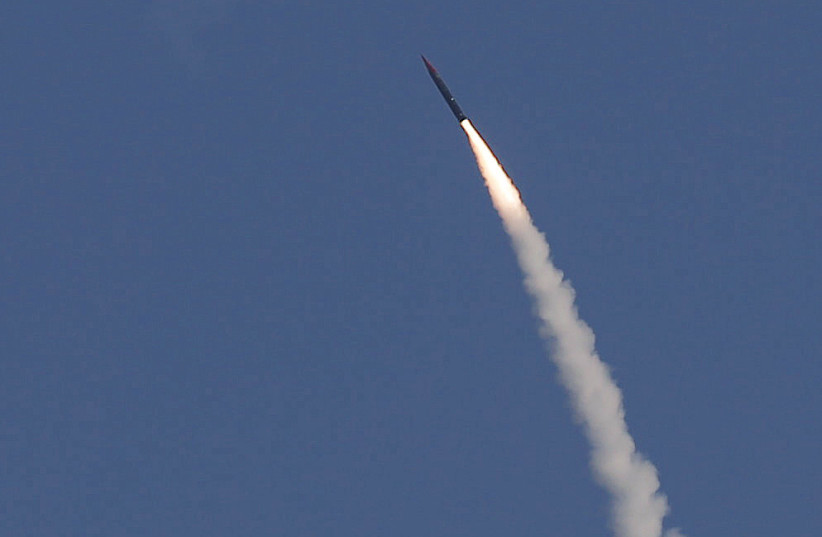The Arab Revolt had been raging for months when David Ben-Gurion invited to his home several of his closest colleagues, and gave them this grim conclusion:
“The danger we face is not pogroms, but annihilation. The attackers will be not only the Arabs of the Land of Israel, but also the people of Iraq and Saudi Arabia, and they have airplanes and cannons,” which meant the Jews will have to do two things: Build an army, “one that will be able to withstand a large attack,” and “establish a suitable industry” [Michael Bar-Zhoar, Ben-Gurion I (Hebrew), p. 374].
Back in 1936, that “suitable industry” meant making bullets and grenades, a minimal menu that by 1948 expanded to mortars and a version of the British submachine gun Sten.
That was then. Now, Israel’s defense industry is among the 10 largest in the world.
Israel is a world leader in the defense industry
Last year alone, Israeli arms exports totaled $12.5 billion, 10% more than the previous year, which itself soared 30% from the previous year, the Defense Ministry reported last week.

Israel makes almost anything that enters a battlefield – from tanks, jets, corvettes, missiles, interceptors and radars, to aerial defense systems, naval missiles, cyber products, avionics and drones. Foreign demand is such that only a quarter of Israeli-made weapons remain in Israel, and half of last year’s export contracts were worth more than $100 million each.
Lurking behind these figures are global trends and Israeli realities, most of them grim, but some actually happy.
THE GLOBAL trend is renewed fear of the Russian bear. The war in Ukraine revived demand for conventional military goods, from fighter jets, battle tanks, artillery batteries and suicide drones, to optical equipment, anti-aircraft radars and missiles of all ranges.
Poland, for instance, is negotiating with the US to buy up to $10b. worth of high-mobility artillery systems and $4b. worth of Abrams tanks, after signing a $6b. deal for South Korean howitzers. Finland increased by $134m. an order for South Korean self-propelled artillery guns.
Romania raised its defense budget from 2% to 2.5% of GDP and is requesting American Abrams tanks. Poland doubled its military spending to 3% of its GDP. Latvia is buying American medium-range naval strike missiles. And the list goes on and on, as sales executives in this week’s Paris Air Show reported.
While this is all wonderful for the arms industry, for the rest of mankind it stinks.
When the Cold War ended, global defense spending began declining. Now, after having already been stemmed by global terrorism, the trend has been reversed, so much so that European defense spending swelled over the past decade by 30%, according to the Stockholm International Peace Institute, which monitors global arms spending. In fact, at $345b., European defense spending now is relatively higher than its level when the Cold War ended in 1989.
War, in short, is back in business. What, then, does this mean for Israel?
THE SAD news for the Jewish state is that 75 years after it made the clunky submachine guns with which it fought its War of Independence, war remains a central feature of Israeli reality and, by extension, a fixture of its industry.
Like it or not, arms are a byproduct of Israeli history.
Israel would never have needed arms if not for its neighbors’ belligerency, and she would never have become an arms manufacturer if not for the difficulties it met buying arms abroad. It was these constraints that made Israel, as early as 1952, start building in a shack outside Lydda Airport what eventually became Israel Aerospace Industries – a defense giant with 15,000 employees and $4.5b. in sales.
Other Israeli constraints were technical. Last century’s big armored battles, in which thousands of Israeli crewmen were killed, made the IDF seek a tank that would protect its crew better than other tanks did. That’s how Israel ended up creating the Merkava, the only tank in the world with the engine in its front.
Ever inventive in such ways, Israel exported arms since the 1950s, leaping within a generation from Uzi submachine guns to Kfir fighter jets. Unfortunately, not all of Israel’s clients were moral democrats. Fortunately, the more the Israeli economy matured, the more arms’ share in national income shrank, from 25% of overall exports in 1985 to 7% today.
That’s not new. What’s new are two mind-boggling developments that in earlier years would have sounded like hallucinations.
The first incredulity is that $3b., meaning 24% of Israel’s record arms exports, went last year to Arab states, namely Morocco, Bahrain and the United Arab Emirates. Is this the beating of swords into plowshares of which any good Israeli dreams? It isn’t. It is, however, a lot better than war.
The second is that landmarks of the past’s Jewish weakness are now buying Jewish power.
In Warsaw, not far from the Monument of Ghetto Heroes, Polish generals decided to equip a fleet of 1,000 infantry combat vehicles with Rafael Spike missiles. In Holland, not far from Anne Frank’s house, Dutch officials recently decided to buy $300m. worth of Haifa-based Elbit’s rocket launchers.
In Bratislava, where a previous Slovak government charged Jews money for transporting them to Auschwitz, the current government is buying Israeli radars, armored personnel carriers and Spike missiles. And in Berlin, not far from where the Wannsee Conference was held, the German government decided to pay $3.8b. for Arrow 3 missiles that intercept hypersonic ballistic missiles.
In other words, the state of the people that a previous Germany resolved to annihilate was just asked by a different Germany to help shield the German people from a prospective nuclear attack.
If anything about the manufacture, trade and deployment of arms can be happy – this is it.
www.MiddleIsrael.net
The writer, a Hartman Institute fellow, is the author of the bestselling Mitzad Ha’ivelet Ha’yehudi (The Jewish March of Folly, Yediot Sefarim, 2019), a revisionist history of the Jewish people’s political leadership.
